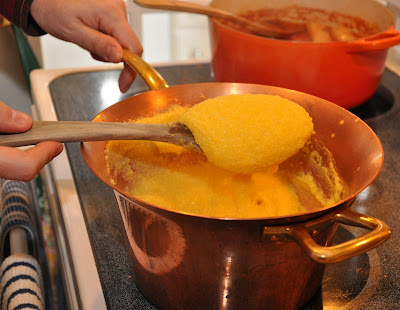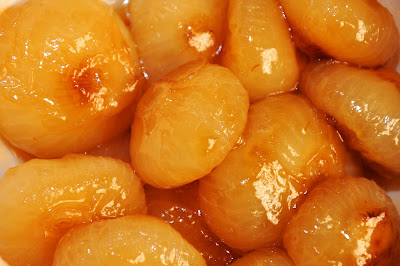Polenta is one of the most emblematic dishes of the northern Italian cuisines from the Veneto to Lombardia to Piemonte. It is also one of the oldest foods eaten in Italy,
dating back at least to 990 BCE. In its original form, polenta—known to the ancient Romans as
pulmentum—was a porridge made from spelt. In later ages other grains such as barley and millet as well as pulses and even chestnuts were used to make various kinds of gruels eaten generally by the poor. It is said to have originally been an Etruscan dish, which the Romans adopted and spread throughout the Empire, although today polenta is not particularly important in the cooking of Tuscany or (with one exception) Lazio. In the 1600s, after maize, a New World grain, was introduced into Italy by the Venetians, polenta took on the form we know today.

Polenta, as befits
la cucina povera, is quite simple to make but requires patience and care. Polenta was traditionally made by the fire, cooked in a copper pot known as a
paiolo, hung close to the fireplace and stirred with a wooden stick known as a
tarai (or
tarel in some areas
). Polenta today is usually made on top of a stove, and besides the traditional method, some modern methods have been developed.
Traditional method for making polenta: In a paiolo or other large pot, preferably made of copper, bring some lightly salted water to the simmer. I find that a ratio of 1 liter (1 quart) of water for 250g (1/2 lb.) of polenta flour works well. Have some more water on hand, simmering in a saucepan or kettle at the back of the stove:
When the water in paiolo has come to the simmer, add the polenta in a constant but gradual stream—in Italian they say 'a pioggia' or like rain—stirring the pot all the while with a whisk or wooden spoon in one direction until all the polenta has been incorporated into the water:
NB: This technique should avoid the awful fate of badly made polenta: the formation of unpleasant lumps or grumi. (I find the use of a whisk, while unconventional, is particularly helpful.) But don't be surprised if you wind up with a few lumps on your first few attempts to make polenta; it is part of the learning process.
The polenta will soon thicken. Turn down the heat to low immediately; be careful, as polenta has a tendency to spatter if it 'boils'. If this happens, take the paiolo off heat for a moment and add some water. That will stop the sputtering, and you can return to the heat and continue to stir:
If you have been using a whisk, you will eventually need toswitch to a wooden spoon as the polenta thickens. Continue stirring and, when the polenta gets too thick to stir without great effort, add some of the hot water you have kept in reserve and continue to stir:
Although some recipes call for you to stir constantly throughout the cooking period to avoid scorching the bottom, I find that if the heat is low enough and you keep the polenta rather loose by adding water from time to time, you only need to stir every so often—say every 5 minutes or so. The polenta should simmer like this for at least 45 minutes, and it is even better after an hour. Some recipes even call for cooking the polenta for 90 minutes—something I've never had the patience to do.
The polenta is done when it is perfectly creamy and has attained the consistency you desire. The polenta should pull away from the pot when you run your spoon across the bottom of the pot:
Depending on your tastes and the use you will be making of the polenta, it can be either all'onda, or rather soft like a risotto, or quite stiff. (More on this later.) If you want a stiff polenta, stop adding water for the last 15-20 minutes or so, and allow the polenta to thicken; you will need to stir more during this final period.
 A nice thick polenta
A nice thick polenta
Pressure cooker method: The traditional method, even without constant stirring, is quite a job. If you want to cut down both on time and effort, you can make polenta in a pressure cooker. To avoid scorching the bottom, use more water than you normally would (say 25% more) and as soon as the polenta begins to thicken a bit, close the lid and bring the pot up to pressure. Turn down the heat to the barest flame, just enough to maintain the pressure, and cook for 20 minutes. Release the pressure, either gradually by just letting it come down by itself off heat, or 'forcing' the pressure down by opening the valve and/or running the pot under cold water in the sink. Remove the lid. Bring the pot back to the stove and over gentle heat begin stirring your polenta. Depending on the consistency you want, add some more water to loosen the polenta or, if it is already rather looser than you want your final product to be, just keep stirring as the polenta thickens.
Slow cooker/rice cooker method: Although I don't own a slow cooker and only occasionally use a rice cooker, I find this method attractive. You mix your polenta flour with cold water (like the pressure cooker, use about 25% more than you would normally) and a pinch of salt in the cooker, close the lid and proceed to cook according to the instructions for your machine (usually 6 hours on low, 3 hours on high). Some recipes call for you to grease the inside of the cooker with a bit of butter or oil to prevent scorching.
Oven method: This is one I've never tried, but it is said that you can make polenta by mixing cold water and polenta flour in a casserole and placing it in moderate oven (180°C, 350°F) to bake for about 45 minutes, stirring it at least once towards the end of the cooking period.
 Electric polenta pot
Electric polenta pot: My favorite method back in Italy was to use an electric paiolo or polenta pot. After the initial addition of polenta flour, as soon as the polenta began to thicken, you attached a paddle with an electric motor to the top of the pot and plugged it in. The paddle would rotate slowly, stirring the polenta, for as long as you wished to cook it. It is a wonderful invention but I had to give it away before leaving Italy, because of the difference in current. Despite having looked high and low, I have not managed to find anything comparable in the US.
Instant polenta: Even in Italy, partially pre-cooked 'instant' polenta, sometimes called polenta lampo or 'lightning polenta', which can be eaten after only 5-10 minutes of simmering, is quite popular. Of course, it goes without saying that both taste and texture suffer when compared to 'real' polenta. But the result is acceptable in some dishes where the polenta is paired with an especially hearty condimento, like the Roman classic, polenta con spuntature e salsicce.
NOTES: Polenta is traditionally served heaped onto a large wooden board, in the middle of which a shallow well is formed to hold the sauce or other condimento to go with it. Served this way, polenta is paired with a broad variety of dishes from meat to vegetables to fish. Traditionally, polenta was cut with a heavy string, served with wooden spoons and eaten on wooden plates, as contact with metal was said to ruin its flavor. (This was the original reason for cooking polenta in copper pot, since unlike other metals copper was said not to have this deleterious effect.) These days, a serving platter will do, and the advent of stainless steel has rendered these precautions unnecessary, although like many, I still use copper and wood implements. It just feels right…
There are other ways to serve polenta. While still warm, thickly cooked polenta (either leftover or made for the purpose) can be spread in a shallow layer on a plate or cookie sheet or other flat surface and left to cool; the polenta hardens as it cools and is then cut into squares or other shapes. These can be fried or grilled and used as a kind of contorno, or as the bed of a crostino. The polenta squares can also be arranged in a casserole with béchamel, cheese and sauce like lasagne to make a 'polenta pasticciata'.

There are various
types of polenta flour you should use according to the region and dish you are making, as well as your personal taste. The most common type of polenta flour is called
bramata, a medium-coarse, yellow cornmeal. It is used for rustic polenta dishes and is well suited for chilling and grilling or baking. It is the kind most often found both inside and (especially) outside Italy. You can use it as a kind of 'all purpose' polenta flour. For a finer texture, which results in a softer, more refined polenta, use the kind of polenta known as
fioretto, which is very finely ground. In parts of northern Italy, particularly in the Veneto, a finely ground white cornmeal called
polenta bianca is quite commonly used to accompany local dishes like
baccalà alla vicentina. A rather unusual, but delicious polenta is made with a mixture of buckwheat and cornmeal, called
polenta taragna, both very coarsely ground. It is very typical of the Valtellina—the Alpine area of Lombardia which is home to the buckwheat pasta known as
pizzoccheri—and also eaten a further to the south, in the areas around Brescia and Bergamo. Rather than a sauce, copious amounts of cheese and butter are usually added just before serving this kind of polenta.
Although polenta is typically thought of (and is) a northern dish, polenta is eaten all over Italy. And although Rome is not really polenta country, in the winter the aforementioned hearty dish of polenta with sausages and spareribs is much appreciated there. Angelina also made polenta, rather soft, served with a simple sugo di pomodoro or with ragu. In my family the story goes that she learned to make polenta to please my grandfather, who had fought in the First World War against the Austrians and, while up north, developed a taste for the stuff. (Following an long tradition, as puls was the usual ration for Roman soldiers in ancient times.) The story may be apocryphal, however, as polenta is also popular in the area she came from around Benevento and Avellino, perhaps a holdover from the times when polenta was enjoyed all over the Roman world.















